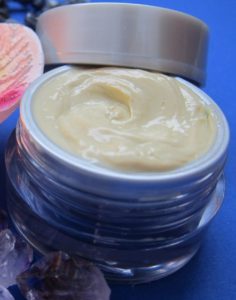Treatment for Rosacea
When taking my aromatherapy course I had a friend ask me what the best treatment for Rosacea was and whether I could use essential oils to create a cream for her, I began to do research and came up with the best essential oils to use in a face cream to help with this skin condition.

Essential Oils for Rosacea
- Chamomile (Roman) – has anti-inflamatory properties, eases puffiness and wrinkles
- Cypress – good for mature skin, oily skin, antiseptic and great for broken capillaries
- Geranium – Cell regenerator, great for broken capillaries, anti-oxidant and great for congested and mature skin
- Juniper – antiseptic properties, great for acne, dermatitis, blocked pores and inflammation
- Sandalwood – Anti-inflammatory, anti-septic, great on dry, aged, cracked and chapped skin
Part of the research was also to find essential oils that blend together well and the above do that well. When blending essential oils for creams it is important to blend base notes first then middle and then top, also a good blend will include a personfier, enhancer, equalizer, and a modifier.
For blending purposes the percentages of each should be:
- Personifier – 1 – 5%
- Enhancer – 50 – 80%
- Equalizer – 10 – 15%
- Modifier – 5 – 8%
Then when blending first add the base notes, the middle and then the top.
After doing the research and figuring out which of the above essential oils would blend well together, I decided on using 4 of the above Sandalwood, Chamomile, Cypress and Juniper.
Natural skin cream Recipe for Rosacea
Part 1
- 19 grams glycerin
- 24 grams stearic acid
- 27 grams emulsifying wax
- 358 grams water
Part II
- 50 grams jojoba oil
- 10 grams wheat germ oil
- 15 grams apricot kernel oil
Part III
Part IV
- 80 drops of Sandalwood (Base Note)
- 40 drops Chamomile (Middle Note)
- 96 drops Cypress (Middle Note)
- 80 drops Juniper (Middle Note)
Directions
- When I make my creams I use the double boiler method and large glass measuring cup. Fill a pot with water (I have a metal rack on the bottom of mine)
- Add Part 1 ingredients to the glass measuring cup and heat
- Add Part II and mix well
- Continue mixing as the mixture cools down
- Add Part III Germaben only when the temperature is below 60 degrees Celsius (140 F)
- Continue to stir and when temperature reaches just below 45 degrees Celsius add the essential oils
- Continue to whisk or stir until it begins to thicken
- Fill your jars and leave lids off while it cools completely down
Get more information on Rosacea here
#handmadesoap #naturalsoap #makingsoapnaturally #soapmaking #soapmaking #soaps #artisansoap #bathandbody #cpsoap #coldprocesssoap #etsy #soapbase #soapcrafter #soapmaker #soaping #soapcrafting #soaphandmade #soap #giftidea #christmas #barsoap #handmadesoap #natural #organic #skincare #coldprocess #soapsupplies #rosaceacream #rosacea #rosaceacreamrecipe
© 2019 – 2024, Tes. All rights reserved.
Could I just buy the cream from you
Hi Laura,
This was a cream that was made specifically for someone, it is not one I make on a regular basis.